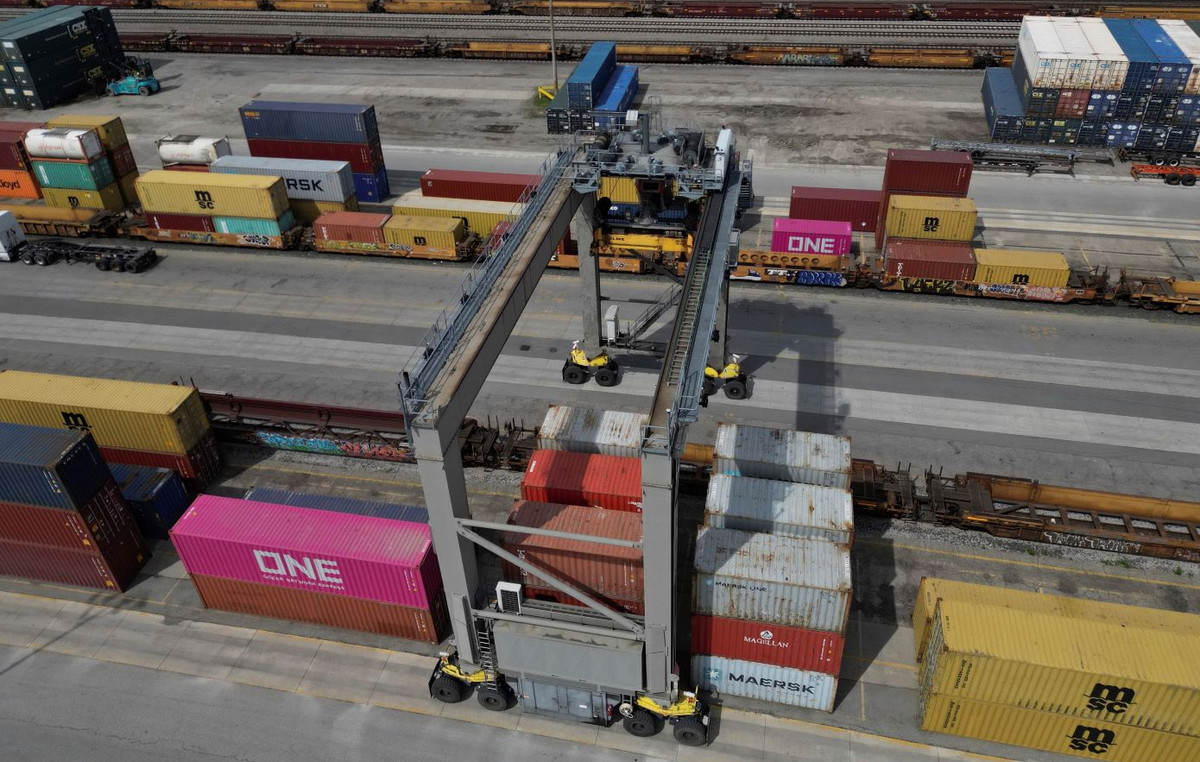Spot the tiny aircraft Elektra Trainer by far it was not an easy task. Despite its bright orange color, the small two-seater plane was barely visible – a small dark speck against a cloudy sky that grew darker by the minute. Furthermore, the aircraft’s electric motors ensured an almost silent approach, offering no clue as to its position.
Until, suddenly, there she was! Members of the E-Flight Challenge team lined up to watch the battery-powered plane descend gracefully onto the island of Norderney, off the northwest coast of Germany.
The landing, just minutes before sunset on August 29, marked the end of the 2023 E-Flight Challenge, which pitted the battery-powered Elektra Trainer aircraft against a sports car. Lucid Motors Air also electric.
Both the aircraft and the car had left that day from Gelnhausen, at an airfield near Frankfurt-am-Main, about 300 kilometers to the south, in an attempt to be the first to reach the island.
The aim of this stunt, conceived by a group of electric mobility enthusiasts, was to showcase the growing capabilities of this promising and rapidly developing technology.
The long road ahead for electric aviation
You could say that the E-Flight Challenge takes inspiration from the early days of aviation.
From Louis Blériot’s leap across the English Channel in 1909 to Charles Lindbergh’s famous solo transatlantic crossing in 1927, the history of aviation has often been made up of competitive challenges that were eagerly accepted by daring pioneers.
After a century, that spirit of discovery has landed in the field of electric aviation – a small segment of the industry that is constantly expanding its capabilities.
Electric cars are becoming popular across the planet and, in countries like Norway, already account for a large majority of new vehicle sales – but it’s a different story in electric aviation.
The power requirements of even the smallest aircraft are on a whole different level compared to cars. Existing battery technology has not yet reached the energy density levels needed to power anything other than the smallest categories of aircraft on short flights. The Elektra Trainer used in the E-Flight Challenge, for example, can carry a maximum of two people.
The batteries currently on the market simply don’t cut it in terms of power. And the idea of adding larger batteries doesn’t work on an aircraft – it would just add a huge amount of weight that could seriously hamper its performance.
Even one of the most ambitious electric aircraft developers, Heart Aerospace – a Swedish startup that has racked up orders and investment from United Airlines and other prominent industry players – announced in 2022 that it was abandoning pure electric propulsion for the aircraft they are developing. .
This was to adopt a hybrid-electric approach that would allow it to develop a commercial plane with up to 30 seats – still a minnow by industry standards.
The technology isn’t there – yet

Italian Tecnam, an aircraft manufacturer that partnered with Rolls-Royce and Norwegian regional airline Widerøe on an electric plane project in 2021, also announced the suspension of its own electric aircraft project this summer, after three years of research, claiming that battery technology is not yet mature enough.
But a recent series of announcements – this time from battery developers – offers solid reasons for hope.
China’s CATL, a global leader in battery technology, announced in April 2023 that it had developed a 500 watt-hour per kilogram battery, which would represent a significant advance – almost double what is currently on the market, which is about of 270 watt-hours per kilogram.
This was followed a few days later by Cuberg, the California-based subsidiary of Swedish battery giant Northvolt, announcing progress in developing a new generation of lithium metal batteries that have been shown in tests to deliver 380 watt-hours per kilogram. – a gain of 40%.
The electrification of larger commercial planes, such as the Airbus A320 and Boeing 737 planes, which carry out the majority of flights today, remains a distant prospect.
Giant Airbus and Boeing have been looking to other technologies, such as hydrogen and sustainable aviation fuels, as decarbonization alternatives, as the idea of a large battery-powered passenger plane currently seems unattainable.
“Given all this uncertainty, we need to take a portfolio approach, continue development and reduce uncertainty. Only then will we be able to decide exactly which solution will be suitable for each part of the market,” Robin Riedel, partner at management consulting firm McKinsey, told CNN .
In 2021, Riedel and this McKinsey team co-authored a study that estimated that 17.4% of global commercial aviation emissions are produced by flights of less than 600 miles (the figure does not include short flights flown by flight schools, flights light aircraft and other forms of private aviation).
This is a segment of the industry that could be decarbonized relatively quickly with new forms of propulsion that are now available, including hybrid electric, battery electric and hydrogen fuel cell electric planes.
The advantages would not just be environmental. Given that electric engines have fewer moving parts than those powered by fossil fuels, advocates of electric aviation are confident that once the range problem is resolved, the lower maintenance and operating costs of electric aircraft will motivate operators to make the change.
Looking to the future

One of the companies eagerly awaiting the arrival of electric aircraft is Berlin-based private aviation operator Air2E, which has supported the E-Flight Challenge. Its founder and CEO, Norbert Werle, likes to draw a parallel with the early years of electric cars.
“Before Tesla became the household name it is now, it released the Roadster, which wasn’t exactly a success, but it paved the way. She showed that it was possible to make amazing electric cars,” he says.
Werle hopes that if electric aircraft provide cost savings, they can also absorb some of the traffic currently traveling by road. This is the assumption on which some entrepreneurs are building the case for new electrically powered regional air mobility businesses.
One of them is Electra.aero, which is developing a hybrid-electric short takeoff and landing (eSTOL) aircraft with the capacity to carry nine passengers or 1,134 kilograms of cargo over distances of up to 805 kilometers.
The justification for developing this type of aircraft is that its lower operational and environmental costs will open up many routes that are not economically viable today, connecting thousands of underutilized airfields in the USA and other countries.
The Virginia-based company, however, remains cautious about all-electric aircraft and has opted for hybrid-electric technology that combines fuel with electric power, much like a hybrid car. She considers that only hybrid technology is capable of offering energy densities closer to those of turboprop aircraft already operated by many regional airlines.
“Airplanes that use only batteries are not a viable solution for these missions in the near future. Even with recent advances, it will likely be decades before battery technology reaches the energy density required to be used in commercially viable battery-only aircraft,” says founder and CEO John Langford.
“It took the automotive industry 15 years to move from viable hybrid electric vehicles to battery-only vehicles, and it’s fair to say the aviation industry will take even longer. Hybrid-electric aircraft allow you to take a significant step toward improving emissions today and can improve as battery technologies evolve.”
The day the car beat the plane

In this context, the E-flight Challenge served as an illustration of the challenges of electric flight – but also of its promise. Although the aircraft was capable of maintaining a relatively straight course over land and sea to Norderney, the road team relied on the Lucid Air car’s advertised 500-mile (805-kilometer) range and the absence of speed limits on long stretches of the German autobahn.
Range would, not entirely unexpectedly, be the aircraft team’s Achilles heel. The Elektra Trainer had to make a pit stop approximately halfway through the route, spending two and a half hours on the ground recharging its batteries at Oerlinghausen airfield. This ultimately caused him to lose the race.
Once the car arrived at the waterway terminal on the north coast of Germany, ready to sail to the island, the game was over. The Lucid Motors team arrived at Norderney Airport at 6:13 pm local time – seven hours after they started. The aircraft arrived about an hour later.
Far from being disappointed, however, the organizers were elated. Who arrived first was a secondary question.
“The achievement was to prove that it is feasible to carry out this all-electric cross-country flight in just one day. The progress compared to just three years ago has been astonishing!” explains Morell Westermann, one of the initiators of the E-Flight Challenge.
In 2020, alongside other electric aviation enthusiasts, Westermann completed a record flight from the foothills of the Swiss Alps to the same island of Norderney, following a similar route, although flying a different model of electric aircraft.
This flight broke six world records, including one for the longest distance flown electrically, the fastest average speed above 100 kilometers, the highest altitude and the fewest stopovers – all for electrically powered flights.
For context, this flight required three days and 11 recharging stops to cover the 700-kilometer itinerary, while the 2023 E-Flight Challenge required just one stop for the 300-kilometer journey between the Frankfurt area and the North Sea.
We can only guess how many stops the next challenge will require, but it is likely that the ceaseless and incremental advances in the field of electric aviation will continue to take its participants further, faster and, of course, without emissions. Westermann, who flies electric planes in his spare time, dares to make a prediction: “In 2026, three years from now, the technology will be mature enough to fly that distance in one go!”
Source: CNN Brasil
Charles Grill is a tech-savvy writer with over 3 years of experience in the field. He writes on a variety of technology-related topics and has a strong focus on the latest advancements in the industry. He is connected with several online news websites and is currently contributing to a technology-focused platform.







